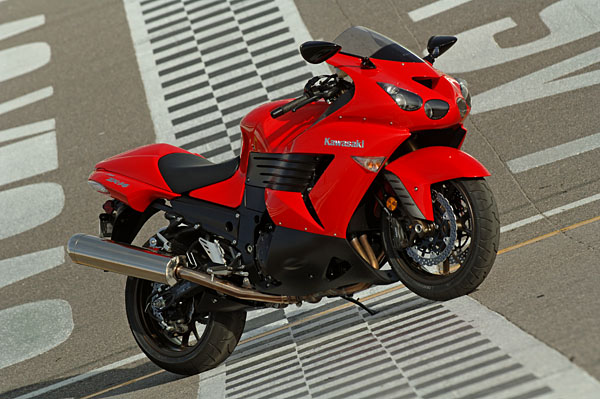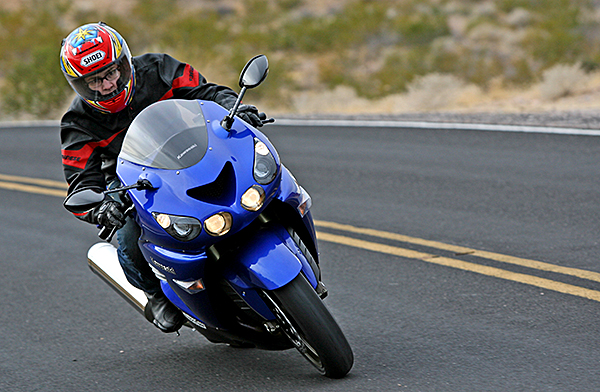 |
| Alex cruises the ZX-14 through a sweeper near Nevada’s Valley of Fire |
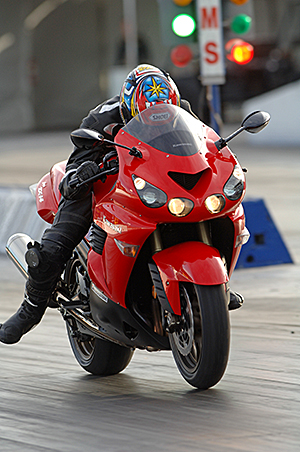 |
| At the dragstrip, the ZX-14 was a rocket |
If you saw Part One of our first riding impression of the 2006 Kawasaki ZX-14, you already know that we like the bike. After having a bit more time to reflect on our Vegas trip, Alex and I put our heads together to come up with a bit deeper analysis of the ZX-14 experience.
It might help to understand what Kawasaki was trying to do when it developed the ZX-14, why this bike is a logical extension of Kawasaki’s performance heritage, and what it might mean to the industry as a whole.
Like many of us, my life-long love affair with motorcycles began as a young man with the sights, sounds and smells I was exposed to. To this day, I remember mowing my front lawn in my early teens, and witnessing a drag race on the residential street in front of my house between a Honda CB750 and a Kawasaki 500cc Mach III (which was an in-line, two-stroke, triple also known as the H1). These bikes represented two very different approaches to performance. The Honda was more refined, quieter and heavier. The Kawasaki was completely raw — a very light bike for its day, with a simple, efficient (power-wise) two-stroke engine bolted to a flexi frame. The result was almost always a dead heat (yes, I saw more than one drag race in front of my house between these two participants).
It was not a dead heat in my mind, however. The Kawasaki H1 won that contest by leaving a more distinct impression. The shriek of the two-stroke triple, and the smell of the premix-fueled exhaust seem like fresh memories thirty years later. When Kawasaki produced the 750cc version of this machine (the H2), it only underscored my impression of this manufacturer as a no-nonsense, hard core performance motorcycle producer.
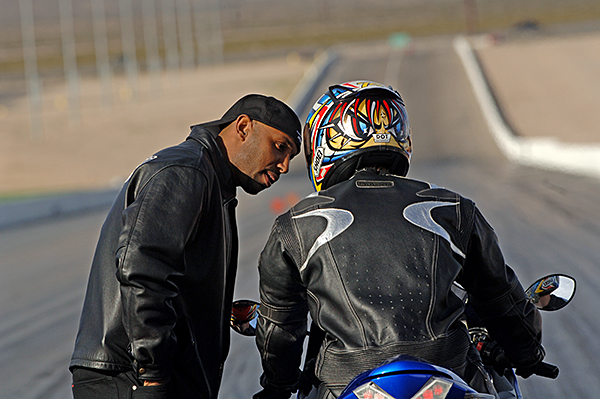 |
| Alex gets some one-on-one instruction from famous drag racer Ricky Gadson |
Of course, Kawasaki eventually went the four-stroke route, but continued its “take no prisoners” attitude towards high performance when it introduced the 900cc Z-1 and, eventually, the GPZ900 and ZX-11.
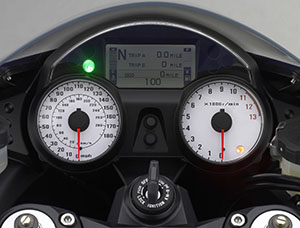 |
| The white-faced speedo and tach are easy to read, and the digital screen displays useful information for touring |
For some reason, along the way, Kawasaki slowly lost its focus, and basically forgot its own heritage. To some extent, its machines became a bit heavier and slower than the competition, and development cycles lagged, as well. Almost suddenly, Kawasaki woke up a few years ago and remembered what fueled the passion of die-hard Kawasaki enthusiasts in the first place . . . kick-ass performance.
The latest example of Kawasaki’s re-awakening is the bike you see here, the flagship ZX-14. Before you label a bike this large, and this powerful irrelevant, read on. Sure, this is a machine by which Kawasaki intends to take its undisputed place at the head of the horsepower table, but it is simultaneously a very usable, unintimidating motorcycle to ride. It also combines tremendous entertainment value with a large dose of practicality by incorporating a balanced chassis and comfortable ergonomics. This bike means a lot more than a 12-gauge shotgun blast down a quarter-mile drag strip.
The raw edge of the early Kawasaki superbikes, like the H1 two-stroke triple, is now only evident in the styling of the ZX-14, which was intended by Kawasaki from the start to be more about attitude and intimidation than good looks. From a performance/engineering perspective, however, the ZX-14 is anything but raw. This is a very carefully engineered, highly refined machine.

That flexy H-1 frame has envolved into the incredibly sophisticated, stout and strong monocoque frame utilized by the ZX-14. Similar in concept to the frame first introduced for the ZX-12R, the ZX-14 frame is a huge backbone that travels over the top of the engine, and incorporates space for the airbox and battery box. Unlike the 12R, the 14 has two balance shafts in the engine that allowed Kawasaki engineers to rigidly mount the engine as a stressed member of the frame structure.
The new frame is both lighter and more rigid that the 12R’s frame, and it allows Kawasaki to achieve a very centralized mass. Much of the fuel, for instance, is located beneath the seat, and the aforementioned battery is also relatively low in the frame and directly central to the bike’s mass.
All of this contributes to one of Kawasaki’s goals, i.e., making the ZX-14 one of the lightest-handling bikes in its class. In fact, we found the ZX-14 combined incredible high-speed stability (journalists who spent time on the Nascar oval said it was rock steady while tapped-out in 6th, presumably at 186 miles per hour) with a nimbleness that belies its size and wheelbase length.
The all-new engine, despite its increased displacement, is no larger physically than the engine in the 12R and produces a claimed 190 horsepower (200 with ram air effect). With 12-to-1 compression and 1352cc, torque output is huge, as well, with a claimed 113.5 pound/feet at 7,500 rpm. Pushing only 474 pounds dry, this engine understandably vaults the ZX-14 forward every time you ask it to, almost regardless of rpm level.

Featuring an inverted fork and a shock with fully adjustable rebound and compression damping, as well as spring preload adjustment, the ZX-14 felt balanced and comfortable on the highway and back roads of Nevada during our test. Unlike the ZX-10R, there is no stock steering damper, but the ZX-14 does not need one. With plenty of weight over the front end, the ZX-14 generally feels planted, and even resists wheelies without a concerted effort on the part of the rider to hoist the front end. The brakes felt more than adequate with radial mounted four-piston front brake calipers (with a separate brake pad for each piston) gripping the petal brake discs.
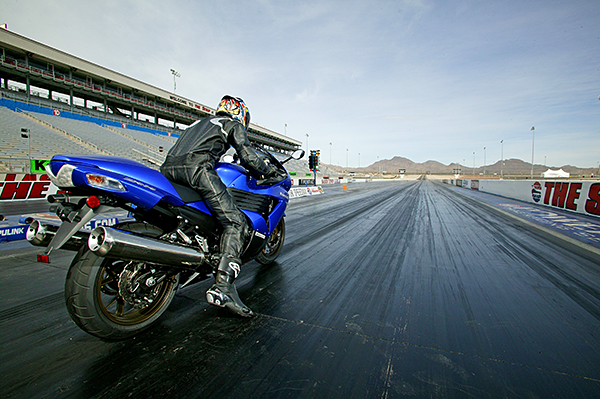 |
| Pull the trigger |
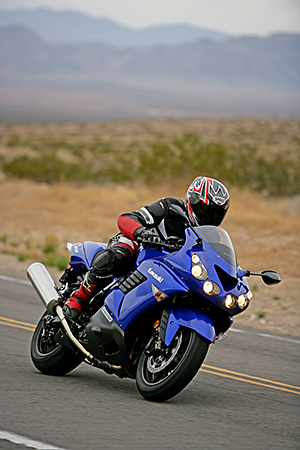
Those four headlights (two low-beam and two-high beam) not only look distinctive, they are powerful. Kawasaki says the headlights are the most powerful it has ever put on a production motorcycle. We believe it. Although riding during the day time, the heavily overcast Nevada sky made us appreciate just how blindingly bright the high beams are (which utilize all four lights at the same time).
The electronics on this motorcycle utilize CAN (Controller Area Network) technology, which saves weight (by using fewer wires) and allows for a greater volume of information delivered to the cockpit. In addition to all of the normal readouts (tachometer, speedometer, trip meters, and fuel gauge), the ZX-14 provides a volume of information normally reserved for dedicated tourers, such as clock, water temperature, gear position indicator, current MPG, average MPG, fuel mileage range, and battery voltage. It even offers adjustable shift rpm and launch rpm warning lights.
Riding the ZX-14 on the street is easy. Despite all its power, the bike is not intimidating to ride, and obeys your commands without fuss.
Steering is surprisingly light, and that stability at 186 mph is evident at much lower speeds where the bike never offers any handling surprises. The transmission shifted smoothly and positively, and the wide spread of power made gear selection largely irrelevant. At freeway speeds, for instance, 4th, 5th and 6th gears all seemed to work just as well.
Wind protection is actually very good, and was a pleasant surprise. Due to the over-the-top frame design, your legs are tucked in fairly tight, and the bodywork directs wind around you, while the windscreen keeps the wind blast off your chest. This rider noticed almost no significant wind buffeting at head level.

The instruments are very legible, with good contrast on both the analog tach and speedometer, as well as the digital readout for the other instruments.
Like any other bike, the ZX-14 has its flaws. We noticed an annoying flat spot at approximately 4,000 rpm. This was confirmed by dyno graphs shown to us by Kawasaki. Perhaps, this can be tuned out with a power commander or similar air/fuel adjustment device.
We also noticed the ZX-14 wanted to understeer a bit on corner exits. Nothing major, but the bike tended to run a little bit wider than we expected until seat time led to a steering adjustment. This could be attributable to suspension set up, but we did not have the time to try and dial this out. The other negative — depending on your perspective — is the styling. Although feelings were mixed, there was plenty of negative commentary about the way the new ZX-14 looks among journalists at the World intro. Personally (and Alex probably disagrees with me on this), the look of the ZX-14 is growing on me. This bike has the attitude of a loner sitting at the top of the food chain, and the design of the bike almost reinforces that in my mind. It is definitely different from what you might see in other motorcycle designs, and Kawasaki never intended it to be “pretty”. Regardless, the looks of this bike could polarize buyers and possibly lose some sales for Kawasaki with a group more concerned with looks than performance.
There can be no question about the performance of the new ZX-14. With relatively inexperienced journalists (such as Alex) getting into the 9s on the drag strip shortly after making this bike’s acquaintance, and the all-day comfort afforded by the ergonomics, this really is a “do it all” machine for the experienced rider.
ZX-14s will be arriving in U.S. dealerships this month at a U.S. MSRP of $11,499. For additional details and specifications, visit Kawasaki’s web site here.
